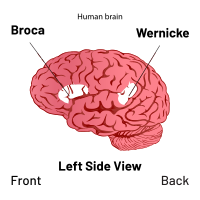
Photo from wikipedia
PURPOSE Manual sign is a common alternative mode of communication taught to children with childhood apraxia of speech (CAS). Gesture use is positively related to later increases in vocabulary and… Click to show full abstract
PURPOSE Manual sign is a common alternative mode of communication taught to children with childhood apraxia of speech (CAS). Gesture use is positively related to later increases in vocabulary and syntactic complexity in typical development, but there is little evidence supporting the use of manual sign for children with CAS. We sought to identify the communicative functions of signs and gestures produced by children with CAS and to identify concurrent factors suggesting which children are more likely to benefit from sign-supported speech intervention. METHOD Measures of receptive and expressive language were gathered from 19 children (ages 3.8-11.1 years) with CAS in a school-based sign-supported speech program. Fourteen of the children produced a total of 145 manual signs, which included both gestures and signs from American Sign Language (M = 10.4 per child, SD = 11.6). Manual signs were coded according to whether they conveyed information that was semantically redundant with (complemented) or added information to (supplemented) their speech. RESULTS Children produced 107 complementary manual signs (75.4%) and 38 supplemental (24.6%) manual signs. Of the 38 supplemental signs, 24 (63.2%) provided additional information in the presence of unintelligible or no speech and 14 (36.8%) provided additional information in the presence of intelligible speech. Children's expressive language scores significantly predicted and accounted for 38.4% of the variance in the number of supplemental signs that children used. CONCLUSION Children with CAS whose oral expressive language was relatively more impaired produced the most supplementary signs, suggesting that children with oral expressive language challenges are more likely to rely on them for communicating words they cannot yet speak. SUPPLEMENTAL MATERIAL https://doi.org/10.23641/asha.21217814.
Journal Title: Language, speech, and hearing services in schools
Year Published: 2022
Link to full text (if available)
Share on Social Media: Sign Up to like & get
recommendations!